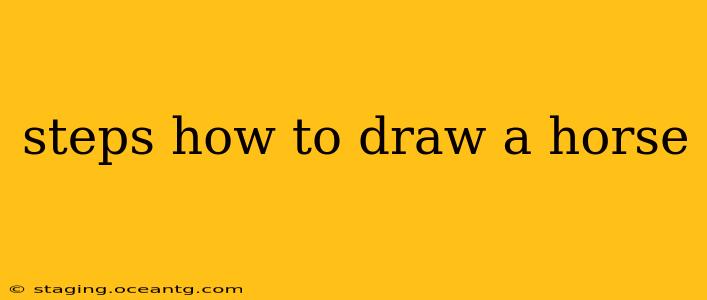How to Draw a Horse: A Step-by-Step Guide for Beginners and Beyond
Drawing a horse might seem daunting, but with a little patience and these step-by-step instructions, you can create a beautiful and realistic representation. This guide caters to all skill levels, from absolute beginners to those looking to refine their equine artistry. We'll cover fundamental shapes, proportions, and details to help you capture the essence of this magnificent animal.
1. Basic Shapes: The Foundation of Your Horse Drawing
Before diving into intricate details, we'll start with simplified shapes to establish the horse's overall structure. Think of it as building a skeleton for your masterpiece.
- The Body: Begin by sketching a large, slightly elongated oval for the horse's body. This oval should be positioned horizontally on your paper.
- The Head: Attach a smaller, more rounded oval to the top left (or right, depending on your perspective) of the larger oval. This will form the head. Make sure there's a slight curve connecting the head and body.
- The Legs: Four slightly curved cylinders will represent the legs. These cylinders should extend downward from the body oval, slightly diverging as they approach the ground. Keep the legs relatively thin in comparison to the body.
- The Neck: Connect the head and body with a slightly curved, elongated cylinder, this is the horse's neck. The neck should appear muscular, but not overly thick.
2. Refining the Proportions: Getting the Anatomy Right
Now that you have the basic shapes, it's time to refine the proportions and add some anatomical accuracy. This stage is key to achieving a realistic horse drawing.
- Neck Placement: Pay attention to the placement of the neck. It should smoothly connect the head and body, avoiding an abrupt transition.
- Leg Length: Ensure the legs are proportionate to the body. The legs should be long and slender, but strong enough to support the horse's weight.
- Muscle Structure: Subtly add suggestions of muscle mass to the legs and body. Horses have powerful muscles, and hinting at these will add realism to your drawing.
- Head Details: Refine the head's shape, paying attention to the muzzle, eye placement, and ear position.
3. Adding Details: Bringing Your Horse to Life
This is where your horse truly comes alive! We’ll add finer details to create a more finished and expressive artwork.
- The Mane and Tail: Add flowing manes and tails, using sweeping, expressive lines. Consider the horse's breed and style when determining the length and texture of the mane and tail.
- Facial Features: Draw in the horse's eyes, nostrils, and mouth. These features are essential for conveying emotion and personality.
- Hooves: Shape the hooves carefully, ensuring they are realistically proportional to the legs.
- Muscle Definition (Advanced): For more advanced artists, this stage allows you to further define the muscle groups, adding anatomical accuracy and depth to your drawing.
4. Refining the Lines and Erasing Guidelines:
Once you're happy with the details, carefully refine your lines, making them smoother and more confident. Gently erase the initial guideline shapes you used to build the structure of your horse.
What are some common mistakes beginners make when drawing horses?
Many beginners struggle with accurately capturing the horse's proportions. The legs are often too short or the neck too thick. Practice sketching the basic shapes repeatedly until you feel confident in your ability to accurately represent the horse's anatomy. Also, paying attention to the musculature and the flow of the mane and tail can be challenging, so take your time and observe real horses or high-quality reference images.
How do I add different breeds of horses in my drawing?
Different horse breeds have distinct physical characteristics. Research the breed you're interested in drawing, paying attention to features such as body type, head shape, coat color, and mane and tail style. Using reference images will greatly help in capturing the breed's unique traits.
What materials should I use to draw a horse?
You can use a variety of materials to draw a horse, from simple pencils and paper to more advanced tools like charcoal or colored pencils. The choice depends on your personal preference and the desired outcome.
By following these steps and practicing regularly, you'll soon be able to confidently draw stunning and realistic horses. Remember, practice makes perfect, so don't be discouraged if your first attempts aren't flawless. Keep practicing, and you'll see your skills develop over time!
